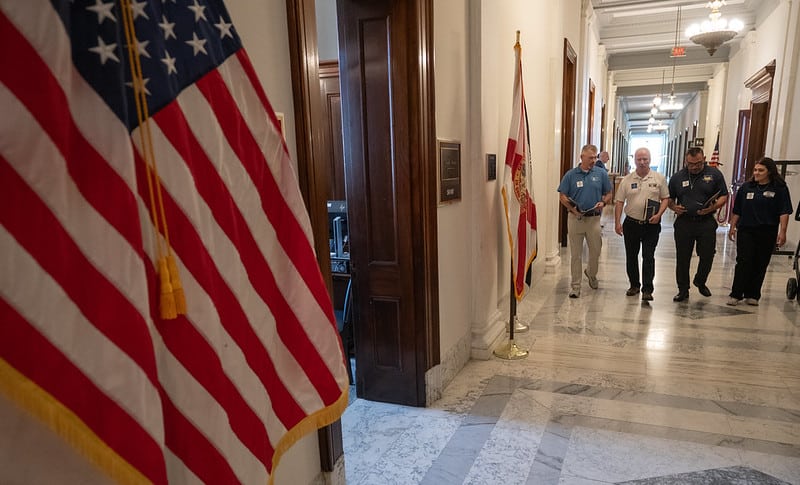
Building the Essential Supply Chain
Matt Thomas was driving Interstate 75 through the Detroit area about two years ago when he caught his first glimpse of “dead” cars—the partially manufactured vehicles marooned on sprawling factory lots amid the shortage of microchips needed for the autos’ safety, entertainment and GPS systems.
The sight sickened Thomas not only because his own set of wheels was getting along in years but because he recognized that he and other union workers stand ready to meet America’s growing demand for ever-more-sophisticated chips.
Federal legislation enacted in August is finally empowering workers for this crucial role. The CHIPS and Science Act, which unions and their Democratic allies pushed through Congress, invests billions to ramp up semiconductor manufacturing across the country and build out the supply chains providing essential materials, parts and components to chip makers.
That will end America’s dangerous over-reliance on foreign chip producers, whose pandemic-related production disruptions and inability to meet surging demand continue to stymie production of new vehicles. Strengthening the nation’s semiconductor industry also will ensure a more reliable supply of the chips needed for many other kinds of consumer goods, along with communications networks, energy systems and the military equipment essential for national security.
The legislation already sparked dozens of manufacturing projects with the potential to create tens of thousands of good-paying jobs all along supply chains.
“There’s no reason why we can’t have these made domestically. There’s no reason why we should have to depend on someone else for production,” said Thomas, a steward for United Steelworkers (USW) Local 12075-24, noting he and his co-workers look for the legislation to boost demand for products like the semiconductor resin they make at a DuPont plant in Midland, Mich.
Manufacturers continually strive to add brainpower to electronic devices, and the advanced packaging resin produced by Local 12075-24 members helps to accomplish this goal. Information on and among chips speeds “up and down, back and forth” with the resin, known as Cyclotene, explained Thomas.
These and other supply chain links are so critical to a robust semiconductor industry that Senate Majority Leader Chuck Schumer chose a USW-represented glass plant in Canton, N.Y., as a backdrop for promoting the CHIPS and Science Act shortly after President Joe Biden signed the legislation in August.
“It’s incredibly important what our plant does,” said Anthony Badlam, president of USW Local 1026, whose members at the Corning facility make specialty glass that’s used as lenses in machines that imprint information on chips.
Because lasers degrade the lenses during the process, he added, “we’re always making new glass” for chip manufacturers.
Corning has indicated its interest in expanding operations at the Canton plant—a facility Schumer predicted will “play an integral role” in the growing semiconductor industry and help “lead and support the future of American manufacturing and tech leadership.”
“It’s all great news for New York,” said Badlam, noting the CHIPS and Science Act will help to secure family-sustaining jobs that workers in his community have relied on for decades.
The expanding semiconductor industry offers similar opportunities to numerous other union workers.
Members of USW Local 105 at the Arconic plant in Davenport, Iowa, for example, make a tooling plate needed for chip manufacturing. And USW members entrusted with dismantling former nuclear energy sites in Oak Ridge, Tenn., Portsmouth, Ohio, and Paducah, Ky., are exploring the feasibility of recovering and supplying nickel, a material in chip manufacturing.
The CHIPS and Science Act also calls for investing billions to carry out advanced research and train workers for new semiconductor manufacturing jobs.
“It’s long overdue,” said Amro El-Jaroudi, associate professor at the University of Pittsburgh’s Swanson School of Engineering, noting the chip shortage forced him onto eBay to buy development boards—an essential learning device for engineering students—at twice the usual cost.
Investments in research will “keep us in a position of leadership” in a critical, evolving field, said El-Jaroudi, a member of the new USW unit now bargaining its first contract with university management, adding that he expects some of his union colleagues to seek CHIPS funding.
The design of the ever more powerful chip is just one of the challenges these researchers face. “You not only have to figure out how to make it,” El-Jaroudi explained, “you also have to figure out how to manufacture it.”
As semiconductor usage exploded—even many popular children’s toys require chips—the number of American manufacturing workers in the industry actually declined amid concentration of manufacturing overseas.
But now, increases in domestic chip manufacturing will require corresponding growth in worker training programs like the one that prepared Thomas for his job at DuPont many years ago. Some manufacturers cited a “severe” and “critical” need for more industry-ready workers even before Biden signed the CHIPS and Science Act.
“There are definitely a lot of specialized jobs that are going to become available in the U.S.,” said El-Jaroudi. “There are a lot of tools people have to learn how to use.”
Badlam and many other union members at the Canton plant have spent decades boosting America’s competitiveness, contributing some of the world’s purest glass for military uses, the Hubble Space Telescope and the windows for NASA spacecraft.
Now, they’re eager to lend their expertise to a battle for global semiconductor supremacy that will create good-paying jobs at the same time.
“These people take it seriously,” Badlam said. “Bring it on.”
By clicking Sign Up you're confirming that you agree with our Terms and Conditions.
Related Blogs
Ready to make a difference?
Are you and your coworkers ready to negotiate together for bigger paychecks, stronger benefits and better lives?

